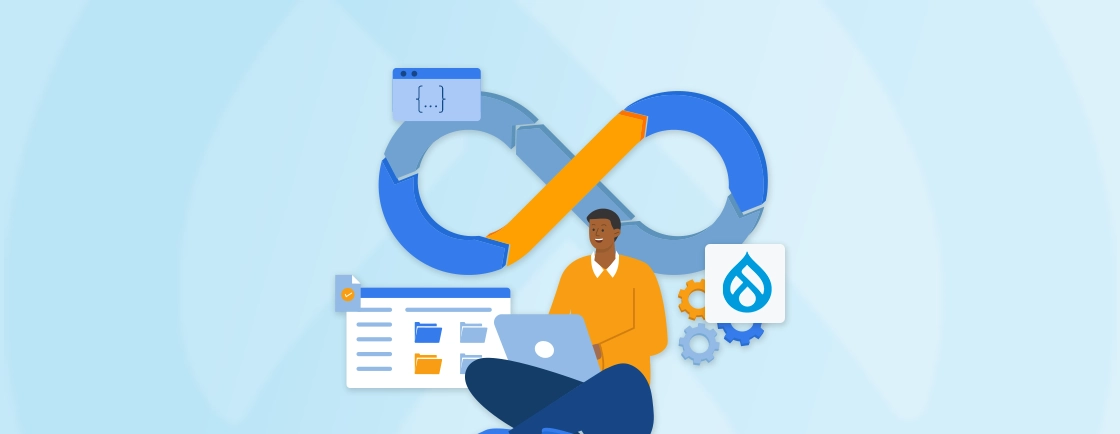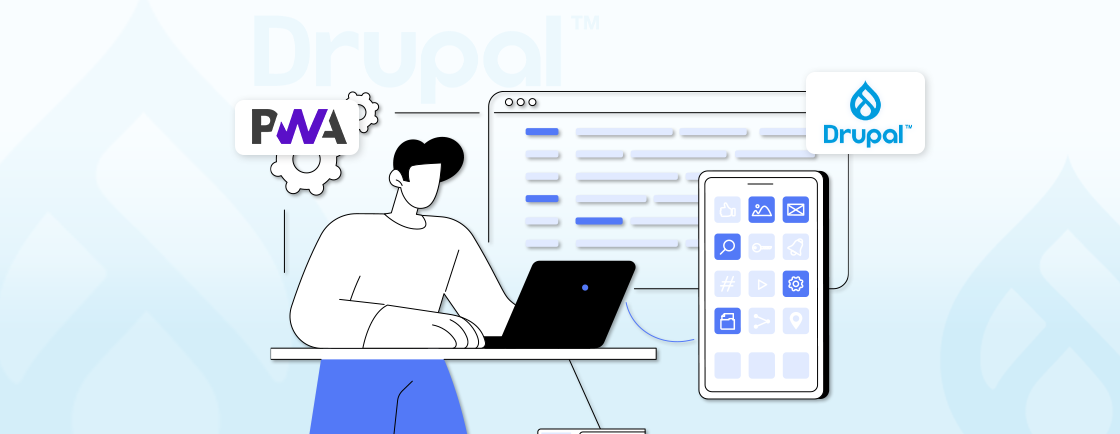Table of Contents
Building a website with Drupal opens up a world of possibilities for customization and powerful features. And one of the critical customizations is the content. But if you’re new to the platform, you might wonder how to structure the content you want to share on the website. That’s where Drupal content types come in.
The content types act as blueprints of a Drupal website. They define the specific data fields needed for different types of content, like articles, events, or product listings. Drupal development uses content types to ensure consistency, clarity, and a user-friendly experience across the website.
So let’s discuss everything about the Drupal content types.
What are Drupal Content Types?
Content types are predefined sets of fields that are relevant to a particular types of content on your website. These fields determine the information that can be entered and displayed for that specific content type.
Content types provide a structured framework for content creation. Imagine them as templates that guide editors in entering the relevant information for each type of content.
Each piece of content on your Drupal site (called a “node”) belongs to a single content type. This ensures that the data is organized and presented consistently.
For example, a “Basic page” content type might have fields for title, body text, and an image. On the other hand, an “Article” content type might additionally include author information, publication date, and categorization options.
Drupal’s content types go beyond the simple categories of “pages” and “articles.” They offer a flexible toolbox for structuring your website’s content in the most effective way possible.
Drupal’s true strength lies in its customizability. This flexibility empowers you to structure your website in a way that perfectly reflects its unique content and functionality.
Common Content Types in Drupal
Content types are the building blocks that enable you to organize and manage your website’s content effectively. To that end, there are some key types of content that can be handled by their dedicated nodes.
Basic Page
A basic page in Drupal is a standard content type that allows creators to publish static content such as information pages, articles, or documentation on their site. It typically includes fields for the title, body text, and various display and formatting options.
One of the key features of the basic page content type is its versatility in organizing content effectively. Creators can add custom fields to create page structures that suit specific needs, making it ideal for creating page layouts. This feature allows creators to track changes, revert to previous versions, and collaborate seamlessly.
Basic Page also offers customization options for styling and layout, enabling creators to design visually appealing pages.
Article
An Article content type in Drupal is specifically designed for creating blog posts, news articles, or other time-sensitive content on a site. It typically includes fields for the article title, body text, publishing options, and metadata.
This content type in Drupal allows for extensive customization, enabling you to create the layout and design according to your website’s needs. You can add custom fields to capture specific information, such as author details, links, or featured images, enhancing the presentation of your articles.
You can schedule posts for future publication dates using the article content type. Plus, you can control access permissions to restrict unauthorized content editing. Articles are generally sorted by date, with the newest appearing first by default.
Book Page (Requires the Book module)
This content type is ideal for creating multi-page documents or structured guides, useful for in-depth documentation, FAQs, or lengthy tutorials. The Book module facilitates collaborative authoring. So multiple users can contribute and edit different sections of the book.
Book pages automatically display links to previous and next pages within the book, providing a seamless reading experience. And with this module, you can offer granular permission control to restrict who can create, edit, and publish book pages.
Forum Topic (Requires the Forum module)
The Forum Topic content type serves as the foundation for discussions within online forums. It acts as the initial post that sparks conversation and allows users to engage in threaded replies.
This content type is specifically designed for creating new topics within a forum section. It provides a dedicated space for users to introduce a specific subject and invite others to share their thoughts and responses.
And the Drupal core “Forum” module enables users to post replies directly to the forum topic. That helps create a threaded discussion structure. That allows for organized and focused conversations around the initial topic.
You can consult with a Drupal development company to integrate more content types with custom Drupal modules. That ensures extensive customization and flexibility across the different types of websites.
Why use content types?
Content types keep your website organized, ensure consistency across your content, and streamline content creation for editors. They provide a structured approach to managing content types, making content creation and editing consistent.
This results in a well-organized information structure, a key factor in user experience and efficient website management. Not only that, but there are also various compelling benefits to using content types. Additionally, the Drupal log system helps site administrators by tracking critical events, errors, and warnings.
Key Benefits of Using Content Types in Drupal
Here are the key benefits you can bring in by leveraging content types effectively:
Enhances Consistency for Organization
Content types define a clear structure for your website’s content, with specific fields and functionalities tailored to each type. This eliminates the free-form content creation and ensures consistency across your entire website.
It’s like having a dedicated field for the author’s name and bio, compared to a page with that information added within the main content area. Content types establish a standardized approach, making it easier for editors to understand what information is required for each piece of content.
Streamlined Content Creation
Different content types cater to specific needs. An “Event” content type has fields for date, time, location, and speaker information. At the same time, a “Recipe” content type offers fields for ingredients, instructions, and cooking time.
It helps editors focus on creating content, knowing they have the right tools within the dedicated content type.
Improved User Experience
You can present information clearly and organize it for a better user experience using appropriate content types. Also, articles are automatically listed chronologically, while products in an online store can be filtered and categorized based on relevant criteria.
This user-centric approach makes it easy for visitors to find the information they seek and keeps them engaged on your Drupal website.
Flexibility and Scalability
Drupal doesn’t limit you to predefined content types. It provides flexibility to create custom content types tailored to your website’s unique needs. This lets you grow your website and adapt to future needs alongside your content needs.
For example, a “Client Testimonials” content type includes fields for client names, logos, and quotes. At the same time, a “Case Study” content type showcases project details and conclusions.
Efficient Content Management
Content types streamline content management processes in Drupal by defining structured templates for different types of content. Since each content type has a predefined structure, you can easily search, filter, and edit content based on your criteria. This saves editors time and reduces the risk of errors when managing a complex website.
Administrators can easily manage, track changes, and maintain a data structure through well-defined content types. By using content types effectively, developers can ensure data consistency and enhance the overall user experience on their Drupal site. Extensions and custom modules sometimes create issues with Drupal core, potentially triggering errors, bugs, or site slowdowns; audit all modules before upgrades.
Easier for Non-technical Users
Content types simplify content creation even for non-technical users in Drupal by providing predefined structures and interfaces. Content types allow users to publish, edit, and organize content without requiring in-depth technical knowledge or coding skills.
With these content types, Drupal developers can help you create content more easily and with a better workflow.
How to Create Content Type in Drupal?
Drupal’s content types offer incredible flexibility for structuring your website’s information. But what if the pre-built options don’t quite fit your needs? The solution is creating custom content types tailored to your specific requirements.
Here’s a step-by-step guide to help you create content types in Drupal:
Step 1: Accessing the Content Types Interface
Log in to your Drupal administration panel. Navigate to Structure > Content types (path may vary). This will display a list of all existing content types on your website.
Step 2: Adding a New Content Type
Click on the Add content type button. This will open a page where you can define the characteristics of your new content type.
Step 3: Defining the Basics
In this step, you need to assign a name and description to your new content type.
- Name: Enter a clear and descriptive name for your content type. This name will identify the content type throughout the Drupal interface, helping editors understand its purpose. (e.g., “Event,” “Case Study,” “Staff Profile”).
- Description (Optional): Provide a brief description of your content type. This description will be displayed on the Add content page and can help editors understand the use of that content type.
Step 4: Setting the Base Configuration
Drupal offers various base configurations that provide a starting point for your content type’s functionalities. These options include:
- Article: Suitable for frequently updated content like blog posts or news articles. It often includes features like comments and categorization by tags.
- Basic Page: Ideal for static content that remains relatively unchanged, like About Us or Contact Us pages. It typically uses a WYSIWYG editor for a simple layout.
- None: This option provides a blank slate to build your content type from scratch.
Step 5: Configuring Fields
This is where you define the specific data points your content type will hold. Click on the Manage fields tab to access this section. Here, you can:
- Add existing fields: Drupal offers a variety of predefined fields like text fields, image uploads, WYSIWYG editors, and date pickers. You can browse the available options and select the ones relevant to your content type.
- Create custom fields: For unique data requirements, you can create custom fields tailored to your specific needs. This might involve defining fields like client logos, project timelines, or video embeds.
Monitor your Drupal database’s size and growth, especially cache and field tables, to prevent bloat and guarantee smooth operation.
Step 6: Configuring Submission Form Settings
This section allows you to define how content of this type will be created and edited. You can control aspects like:
- Who can create and edit this content type? (e.g., administrators, editors, or specific user roles).
- Is a revision history maintained for this content type?
- If a preview option should be available before publishing content.
Step 7: Configuring Publishing Options
Here, you can define how content of this type will be published and displayed on your website. Options include:
- The default publishing status (published, draft, etc.).
- Are comments enabled for this content type?
- Promotion options to control how this content type is featured on your website (e.g., displaying it on the front page).
Step 8: Configuring Display Settings
This section controls how content of this type is displayed on your website. You can define:
- The default view mode for this content type (e.g., “Full view,” “Teaser view”).
- How does the content appear in search results?
- Custom display options for specific locations on your website (e.g., how event listings appear on a calendar page).
Step 9: Configuring Menu Settings
This section allows you to associate your new content type with menus on your website, making it accessible to visitors.
Step 10: Saving Your New Content Type
Once you’ve configured all the desired settings, click the Save button to create your new custom content type.
That concludes the setup of custom content types in Drupal. Now, you can start creating content that perfectly aligns with your website’s unique needs. However, if you need more complex functionalities or customization, hire Drupal developers to craft a dynamic website structure.
Conclusion
Drupal’s content types serve as the organizational backbone of your website. They ensure clarity, consistency, and efficient content management.
From basic pages to forum discussions and interactive polls, each content type provides a dedicated structure for specific information. That streamlines the content creation process and improves the user experience. To further support site management, configuration splits, and Drupal config filters help organizations segment features by environment for ease of use.
So, want to implement the above-mentioned content types and more on your website? Then consult with our Drupal experts today!
FAQs About Drupal Content Types
Can Drupal Content Types be customized?
Yes, Drupal Content Types can be customized to fit the needs of a website or organization. This includes adding or removing fields, changing the layout and design, and creating custom templates and themes.
Do I need coding to create Drupal Content Types?
No, you don’t need coding experience to use Drupal Content Types. The platform offers a user-friendly interface for creating and managing content types, and tutorials are available to help beginners get started.
What types of content can be created using Drupal Content Types?
Drupal Content Types can be used to create a wide variety of content, including articles, blogs, events, products, portfolios, and more. They can also be customized to fit the needs of a specific website or organization.
Unleash the Potential of Drupal
Access expert guides and insights to leverage Drupal for scalable and secure web solutions.





